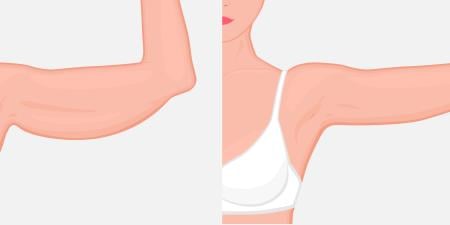Case
Julie was feeling both happy and sad. She had just tucked her 7-week-old baby girl into her crib, and was overjoyed about being the mother of two adorable, healthy children. However, she caught a glimpse of herself in the mirror as she was changing into her pajamas and was disappointed by what she saw.
Since being discharged from the hospital, Julie had been doing aerobic workouts every day, trying to regain her figure. At 34, she was hoping not merely to return to her prepregnancy weight, but to recapture the body of her 20s, when she had won third place in a statewide beauty pageant.
She was down to 146 pounds, certainly within normal limits for a 5-foot, 8-inch woman (body mass index 22.2), but was not the 123 pounds that she weighed walking down the runway. Julie had struggled to lose weight after giving birth to her first child 6 years before, but it was even more difficult after her second child. She had lost 8 pounds over the last 6 weeks, but seemed to be hitting a plateau.
Inspired by an advertisement she had seen for a “mommy makeover” package, Julie set up an appointment with Dr. Greenwall, a plastic surgeon who had fixed her broken nose after she was hit in the face by a volleyball a few years earlier. Julie told Dr. Greenwall how difficult weight loss had been postpartum, how the extra weight around her belly made her self-conscious, and that she wanted to remain attractive in her husband’s eyes to keep her marriage stable. She requested a tummy tuck (abdominoplasty) and liposuction in hopes of losing some postpregnancy weight and maintaining her marriage, and asked if Dr. Greenwall would give her a discount for having both procedures together, as she had seen in the ad.
Commentary
In this case a 34-year-old woman, 7 weeks postpartum, is unhappy with her appearance and is interested in plastic surgery. Specifically, after reading an advertisement for “mommy makeovers” she has a consultation with a plastic surgeon requesting an abdominoplasty and liposuction. This case raises several questions. Can a woman with a normal body mass index who has given birth so recently be an appropriate candidate for an abdominoplasty and liposuction? How can Dr. Greenwall manage that woman’s expectations, especially those regarding “maintaining her marriage?” Is it ethically appropriate to create or advertise cosmetic surgery packages?
Is Julie an Appropriate Candidate?
As with any patient’s consultation, the surgeon should start by listening to Julie’s concerns, reviewing her medical history, and examining her. (For any elective cosmetic procedure, it is important that the patient is in good medical condition.) After discussing the findings with Julie, Dr. Greenwall should turn to her concerns and should explain expectations for the normal course of recovery from her recent pregnancy. Often the surgeon starts this conversation by saying, “Your body had 9 months to get out of shape and usually it will require as many months to get back in shape.” This is particularly true for women who have been through more than one pregnancy. It often takes longer for a woman’s body to recover after subsequent pregnancies than after her first. Seven weeks is inadequate time for this recovery. Julie will need 6 months or more. During that recovery period, after she obtains approval from her obstetrician, she can start an exercise routine and a healthy diet. Any balanced, calorie-restricted diet that the patient will comply with is acceptable.
There is another reason not to rush into surgery at this point. If Julie allows herself time to recover, and still wants to consider abdominoplasty surgery, she must decide whether she wants to have any more children. In addition to nullifying the benefit of prior abdominoplasty surgery, pregnancy and delivery may be problematic after this procedure. Other body contouring surgery should also be delayed until after Julie has decided not to become pregnant again. At this point, Julie may not yet be in a position to decide.
More generally, can a woman who has a normal BMI be an appropriate candidate for body contouring procedures? Body contouring procedures should not be a substitute for exercise and weight management. Still, many women, especially after two pregnancies, have body changes that persist even several months after pregnancy, despite exercise and diet regimens. It is not uncommon for abdominal laxity, excess skin, and unwanted fat deposits to persist. If they do, and the patient wants surgical correction, abdominoplasty or liposuction are appropriate considerations. Patients may also want a breast reduction or breast lift, or may be unhappy with their fat distribution, despite having a relatively normal BMI and exercising regularly. For example, excess fat in the lateral waist/flanks region and upper leg are common. These regions can often be reduced with liposuction procedures.
Julie’s Expectations
The issue of “maintaining her marriage” is more complex. Plastic surgery is not going to help Julie stay married. A marriage is a complex relationship, and the surgeon should ask why Julie is so worried about hers. She should be advised to seek professional counseling, not surgery, to address concerns about her relationship. The surgeon can elicit Julie’s concerns with open-ended questions like “Why are you concerned about maintaining your marriage?” Given that Julie won third place in a statewide beauty pageant, it might also be appropriate to ask a question about the importance of appearance: “I know that you have previously competed in beauty pageants and that your appearance is very important to you. Could you tell me more about that?” Furthermore, physicians have a responsibility to screen their patients for intimate partner violence.
The patient in this case is 7 weeks past delivery. As such, she is going through a demanding life transition. This should also be considered during the course of the consultation. Julie may be experiencing postpartum depression. Current literature states that 13 percent of women suffer from postpartum depression, which tends to emerge within 6 months of delivery [1]. Marital problems during pregnancy can increase risk for postpartum depression [1]. Patients should be asked about suicidal and infanticidal ideation, and further psychiatric evaluation should be sought if appropriate.
Elective Surgery Packages
The final issues to be addressed concern the “mommy makeover” package that brought Julie into Dr. Greenwall’s office. Firstly, is it unethical to create package deals, whether they are advertised publicly or merely offered during visits, that offer patients an incentive to have procedures they are not already seeking? Though combining procedures may, under particular circumstances, optimize a patient’s results, the appropriateness of a given combination can only be determined by evaluating the individual patient. Advertising a “package” can imply that it is appropriate for anyone who reads the ad and may encourage patients to have a combination of procedures that they do not need. Furthermore, implying to patients that they “need” the package can affect self-image. As discussed, women who have recently given birth may already be struggling with self-image concerns. The thought that their situation necessitates a “package” that they previously had not considered may increase distress.
There are multiple standards for ethical advertising [2, 3, 4]. Advertising a “mommy makeover” does not in itself violate any of them, but the details of an advertisement can violate ethical standards for advertising not only by implying, as discussed above, that any reader is an eligible candidate, but also by making unfounded claims. Unless true, the ad should not imply that the surgeon has any special talents or techniques. To uphold patients’ trust in the medical community, the advertisements should disclose enough information to avoid being misleading. Rather, as discussed, each patient should be evaluated as an individual and offered appropriate treatment options.
References
- O’Hara MW, Swain AM. Rates and risk of postpartum depression—a meta-analysis. Int Rev Psychiatry. 1996;8(1):37-54.
-
American Medical Association. Opinion 5.02 Advertising and Publicity. Code of Medical Ethics. Chicago, IL: American Medical Association; 2008-2009. http://www.ama-assn.org/ama/pub/physician-resources/medical-ethics/code-medical-ethics/opinion502.shtml. Accessed April 13, 2010.
- Dyer AR. Ethics, advertising and the definition of a profession. J Med Ethics. 1985;11(2):72-78.
-
American Academy of Orthopedic Surgeons. Opinions on ethics and professionalism 1205: advertising and the orthopedic surgeon. http://www.aaos.org/about/papers/ethics/1205eth.asp. Accessed April 13, 2010.



